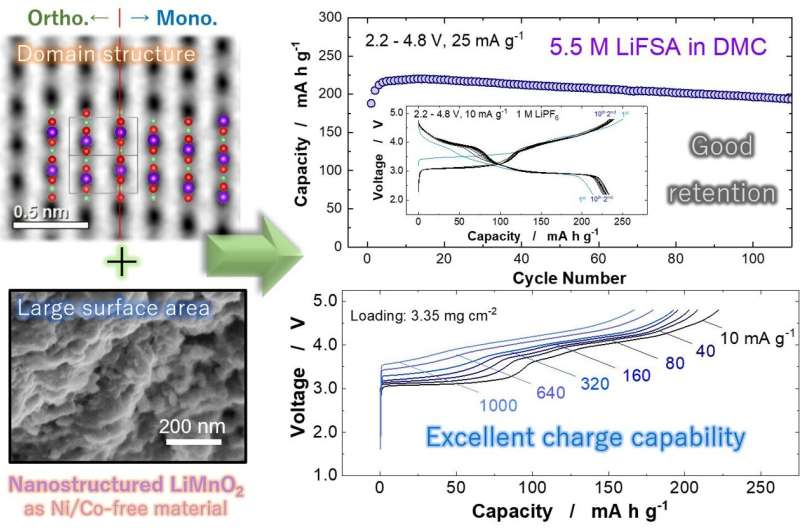This article has been reviewed according to Science X's editorial process and policies. Editors have highlighted the following attributes while ensuring the content's credibility:
fact-checked
peer-reviewed publication
trusted source
proofread
LiMnO₂ electrodes could replace Ni/Co in electric vehicle batteries

Lithium-ion (or Li-ion) batteries are heavy hitters when it comes to the world of rechargeable batteries. As electric vehicles become more common in the world, a high-energy, low-cost battery utilizing the abundance of manganese (Mn) can be a sustainable option to become commercially available and utilized in the automobile industry.
Currently, batteries used for powering electric vehicles (EVs) are nickel (Ni) and cobalt (Co)-based, which can be expensive and unsustainable for a society with a growing desire for EVs.
By switching the positive electrode materials to a lithium/manganese-based material, researchers aim to maintain the high performance of Ni/Co-based materials but with a low-cost, sustainable twist.
Researchers published their results in ACS Central Science on 26 Aug. 2024.
Li-ion batteries are not new players in the field of rechargeable electronics, but there are always ways to innovate and improve already reliable methods. LiMnO2 as an electrode material has been studied in the past but has always been limited by restrictive electrode performance.
"Through the systematic study on different LiMnO2 polymorphs, it is found that the monoclinic layered domain effectively activates structural transition to the spinel-like phase. From this finding, nanostructured LiMnO2 with the monoclinic layered domain structures and high surface area has been directly synthesized by using a simple solid-state reaction," said Naoaki Yabuuchi, author and researcher of the study.
A monoclinic system refers to the type of group symmetry of a solid crystalline structure. A Li/Mn arrangement with the monoclinic symmetry appears to be key in making LiMnO2 a feasible option for a positive electrode material.
Without the structural phase transition the monoclinic domain allows, electrode performance would be limited thanks to the sub-optimal crystalline structure of LiMnO2 and accompanying phase transitions.
After observing and testing the various polymorphs, it was determined the needed structure can be synthesized directly from two components without having to use an intermediary step. The resulting material is competitive with nickel-based layered materials and boasts excellent fast-charging abilities, which is indispensable for electric vehicles.
The nanostructured LiMnO2 with the monoclinic layered domain is synthesized by a simple calcination process to yield a product with a high-energy density, reaching 820 watt-hours per kilogram (Wh kg-1), compared to about 750 Wh kg-1 for nickel-based layered materials and 500 Wh kg-1 for other low-cost lithium-based materials.
There is also no reported voltage decay using nanostructured LiMnO2, which is common in manganese-based materials.
Voltage decay is a phenomenon in which the voltage decreases gradually, over time reducing the performance and responsiveness of electronics. However, it does not seem to be an observable issue in the case of nanostructured LiMnO2, which is the subject of the study.
Though there are promising results, a practical issue can be observed: the dissolution of manganese. Over time, manganese can dissolve due to many factors, such as phase changes or reacting with acidic solutions. Fortunately, this can be curbed or completely mitigated by the use of a highly concentrated electrolyte solution and a lithium phosphate coating.
Researchers hope their findings contribute to a more sustainable energy source than fossil fuels, especially concerning electric vehicles.
The performance of LiMnO2, with its competitive energy density compared to nickel-based materials, demonstrates the potential alternative materials can have to produce environmentally friendly products that are sustainable both in production and as a long-term investment.
An ideal future for nanostructured LiMnO2-based electrode materials would involve commercialization and industrial production in the luxury electric vehicle industry.
More information: A Practical and Sustainable Ni/Co-free High-Energy Electrode Material: Nanostructured LiMnO2, ACS Central Science (2024). DOI: 10.1021/acscentsci.4c00578


















